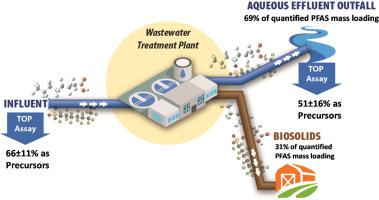Water Research ( IF 11.4 ) Pub Date : 2023-02-10 , DOI: 10.1016/j.watres.2023.119724 Charles E Schaefer 1 , Jennifer L Hooper 2 , Laurel E Strom 2 , Ibrahim Abusallout 2 , Eric R V Dickenson 3 , Kyle A Thompson 4 , Gayathri Ram Mohan 5 , Dina Drennan 2 , Ke Wu 6 , Jennifer L Guelfo 6

|
Both quantifiable and semi-quantifiable poly- and perfluoroalkyl substances (PFAS) were evaluated in the influent, effluent, and biosolids of 38 wastewater treatment plants. PFAS were detected in all streams at all facilities. For the means of the sums of detected, quantifiable PFAS concentrations were 98 ± 28 ng/L, 80 ± 24 ng/L, and 160,000 ± 46,000 ng/kg (dry weight basis) in the influent, effluent, and biosolids (respectively). In the aqueous influent and effluent streams this quantifiable PFAS mass was typically associated with perfluoroalkyl acids (PFAAs). In contrast, quantifiable PFAS in the biosolids were primarily polyfluoroalkyl substances that potentially serve as precursors to the more recalcitrant PFAAs. Results of the total oxidizable precursor (TOP) assay on select influent and effluent samples showed that semi-quantified (or, unidentified) precursors accounted for a substantial portion (21 to 88%) of the fluorine mass compared to that associated with quantified PFAS, and that this fluorine precursor mass was not appreciably transformed to perfluoroalkyl acids within the WWTPs, as influent and effluent precursor concentrations via the TOP assay were statistically identical. Evaluation of semi-quantified PFAS, consistent with results of the TOP assay, showed the presence of several classes of precursors in the influent, effluent, and biosolids; perfluorophosphonic acids (PFPAs) and fluorotelomer phosphate diesters (di-PAPs) occurred in 100 and 92% of biosolid samples, respectively. Analysis of mass flows showed that, for both quantified (on a fluorine mass basis) and semi-quantified PFAS, the majority of PFAS exited WWTPs through the aqueous effluent compared to the biosolids stream. Overall, these results highlight the importance of semi-quantified PFAS precursors in WWTPs, and the need to further understand the impacts of their ultimate fate in the environment.
中文翻译:

美国废水处理厂中可量化和半可量化的多氟烷基和全氟烷基物质的出现
在 38 个污水处理厂的进水、出水和生物固体中评估了可量化和半可量化的多氟烷基和全氟烷基物质 (PFAS)。在所有设施的所有流中都检测到 PFAS。对于检测到的、可量化的 PFAS 浓度总和的平均值,进水、出水和生物固体(分别)为 98 ± 28 ng/L、80 ± 24 ng/L 和 160,000 ± 46,000 ng/kg(干重) . 在进水流和流出水流中,这种可量化的 PFAS 质量通常与全氟烷基酸 (PFAAs) 有关。相比之下,生物固体中可量化的 PFAS 主要是多氟烷基物质,它们可能作为更顽固的 PFAA 的前体。对选定的进水和出水样品进行总可氧化前体 (TOP) 测定的结果表明,半定量(或,与量化的 PFAS 相关的氟质量相比,未识别的)前体占氟质量的很大一部分(21% 至 88%),并且这种氟前体质量在污水处理厂内没有明显转化为全氟烷基酸,因为流入和流出的前体浓度通过TOP 测定在统计学上是相同的。与 TOP 测定结果一致的半定量 PFAS 评估表明,进水、出水和生物固体中存在几类前体;全氟膦酸 (PFPAs) 和氟调聚物磷酸二酯 (di-PAPs) 分别出现在 100% 和 92% 的生物固体样品中。质量流量分析表明,对于定量(基于氟质量)和半定量 PFAS,与生物固体流相比,大多数 PFAS 通过废水排出污水处理厂。总体而言,这些结果突出了半定量 PFAS 前体在污水处理厂中的重要性,以及进一步了解其最终归宿对环境影响的必要性。
















































 京公网安备 11010802027423号
京公网安备 11010802027423号